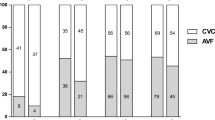Abstract
Current data demonstrate pediatric patients who remain on hemodialysis (HD) therapy are more likely to be dialyzed via central venous catheters (CVCs) than arteriovenous grafts (AVGs) and fistulae (AVFs). We retrospectively compared complications and health-related quality of life (HRQOL) associated with different vascular access types at two large centers over a 1-year period. Patients included in the study were younger than 25 years of age, weighed >20 kg, and had received HD for at least 3 months. Thirty CVC patients and 21 AVG/AVF patients received a total of 2,393 and 3,506 HD treatments, respectively. The infectious complication rate was higher for CVC patients, who were hospitalized 3.7 days for each 100 HD treatments versus 0.2 days for AVG/AVF patients (p < 0.01). CVC patients also had a much higher rate of access revision, needing 2.7 hospital days every 100 HD treatments compared with 0.2 days for AVG/AVF patients (p < 0.01). HRQOL scores did not differ between groups. Thus, despite similar HRQOL, CVCs were associated with more complications and greater morbidity when compared with AVG/AVFs. These findings further emphasize the need to use AVG/AVFs as primary HD access for pediatric patients expected to receive a long course of maintenance HD.
Similar content being viewed by others
References
D’Cunha PT, Besarab A (2004) Vascular access for hemodialysis: 2004 and beyond. Curr Opin Nephrol Hypertens 13:623–629
National Kidney Foundation (2006). KDOQI Clinical Practice Guidelines and Clinical Practice Recommendations for 2006 Updates: Hemodialysis Adequacy, Peritoneal Dialysis Adequacy, and Vascular Access. Am J Kidney Dis 48(Suppl 1):S1–S322
Neu AM, Ho PL, McDonald RA, Warady BA (2002) Chronic dialysis in children and adolescents. The 2001 NAPRTCS Annual Report. Pediatr Nephrol 17:656–663
Neu AM, Fivush BA, Warady BA, Watkins SL, Friedman AL, Brem AS, Goldstein S, Frankenfield DL (2003) Longitudinal analysis of intermediate outcomes in adolescent hemodialysis patients. Pediatr Nephrol 18:1172–1176
Fischbach M, Edefonti A, Schroder C, Watson A, The European Pediatric Dialysis Working Group (2005) Hemodialysis in children: general practical guidelines. Pediatr Nephrol 20:1054–1066
Wasse H, Kutner N, Zhang R, Huang Y (2007) Association of initial hemodialysis vascular access with patient-reported health status and quality of life. Clin J Am Soc Nephrol 2:708–714
Feldman HI, Kobrin S, Wasserstein A (1996) Hemodialysis vascular access morbidity. J Am Soc Nephrol 7:523–535
Stevenson KB, Hannah EL, Lowder CA, Adcox MJ, Davidson RL, Mallea MC, Narasimban N, Waguild JP (2002) Epidemiology of hemodialysis vascular access infections from longitudinal infection surveillance data: predicting the impact of NKF-DOQI clinical practice guidelines for vascular access. Am J Kidney Dis 39:549–555
Sheth RD, Brandt ML, Brewer ED, Nuchtern JG, Kale AS, Goildstein SL (2002) Permanent hemodialysis vascular access survival in children and adolescents with end-stage renal disease. Kidney Int 62:1864–1869
Brittinger WD, Walker G, Twittenhoff WD, Konrad N (1997) Vascular access for hemodialysis in children. Pediatr Nephrol 11:87–95
Ramage IJ, Bailie A, Tyerman KS, McColl JH, Pollard SG, Fitzpatrick MM (2005) Vascular access survival in children and young adults receiving long-term hemodialysis. Am J Kidney Dis 45:708–714
Fadrowski JJ, Hwang W, Frankenfield DL, Fivush BA, Neu AM, Furth SL (2006) Clinical course associated with vascular access type in a national cohort of adolescents who receive hemodialysis: findings from the Clinical Performance Measures and US Renal Data System projects. Clin J Am Soc Nephrol 1:987–992
Varni JW, Seid M, Kurtin PS (2001) PedsQL 4.0: reliability and validity of the Pediatric Quality of Life Inventory version 4.0 generic core scales in healthy and patient populations. Med Care 39:800–812
Goldstein SL, Graham N, Burwinkle T, Warady B, Farrah R, Varni JW (2006) Health-related quality of life in pediatric patients with ESRD. Pediatr Nephrol 21:846–850
Goldstein SL, Macierowski CT, Jabs K (1997) Hemodialysis catheter survival and complications in children and adolescents. Pediatr Nephrol 11:74–77
Sheth RD, Kale AS, Brewer ED, Brandt ML, Nuchtern JG, Goldstein SL (2001) Successful use of Tesio catheters in pediatric patients receiving chronic hemodialysis. Am J Kidney Dis 38:553–559
Goldstein SL (2007) Advances in renal replacement therapy as a bridge to renal transplantation. Pediatr Transplant 11:463–470
Agarwal AK, Patel BM, Haddad NJ (2007) Central vein stenosis: a nephrologist’s perspective. Semin Dial 20:53–62
Acknowledgments
This work was supported in part by USPHS grants DK-35423 and DK-67563 and funds from the Casey Lee Ball Foundation.
Author information
Authors and Affiliations
Corresponding author
Rights and permissions
About this article
Cite this article
Zaritsky, J.J., Salusky, I.B., Gales, B. et al. Vascular access complications in long-term pediatric hemodialysis patients. Pediatr Nephrol 23, 2061–2065 (2008). https://doi.org/10.1007/s00467-008-0956-1
Received:
Revised:
Accepted:
Published:
Issue Date:
DOI: https://doi.org/10.1007/s00467-008-0956-1




